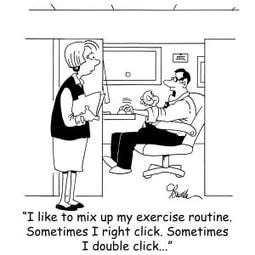 Even in this age when text is often reduced down to 140 characters or less, don’t forget the punctuation. It just could save a life! I recently went to visit my boys at their summer camp. While driving near Algonquin Provincial Park, I saw a handmade sign posted on a front lawn that read “Slow Kids Crossing.” I was so distracted by the sign (do they mean their kids are physically or mentally slow?) that I could have accidentally hit someone. It is safe to assume they intended “Slow, Kids Crossing” (or “Slow Down, Kids Crossing” would have been better), but this example goes to show the power of punctuation. The lack of punctuation in this sign obscured the intended meaning. For those of us who notice this sort of thing, it can be annoying—and sometimes amusing. Lynne Truss, author of Eats, Shoots & Leaves: The Zero Tolerance Approach to Punctuation, says: “We are like the little boy in The Sixth Sense who can see dead people, except that we see can see dead punctuation.” The comma is especially complicated because it plays a grammar role, but also a role as an indicator of the rhythm and flow of the sentence. It is also the most controversial punctuation mark. People have very strong opinions about the Oxford (or serial) comma, but I will leave that heated topic for another post (there has already been enough bloodshed). The comma indicates a slight break between different parts of a sentence. The function of the comma is to group together words, phrases, and clauses to make a sentence clearer to read. The effect of a misplaced or omitted comma can be quite comical at times. Here are some examples from 25 Biggest Comma Fails on BuzzFeed:
Commas with relative clauses
 A trick to make sure you have used the commas correctly is to take the information enclosed by the commas out from the sentence and see if the sentence still makes sense and conveys the meaning you intended. Commas with dependent clauses Commas with introductory words and phrases
Commas with independent clauses Commas with parenthetical and descriptive phrases
I hope you learned something from this very general introduction to using the comma. Stay tuned for a separate post in which I will discuss the use of the comma in lists.
Happy Adventures in Editing!
0 Comments
 Image from CartoonStock.com (used with permission) Image from CartoonStock.com (used with permission) In my last post, I discussed the results of a recent study that found our sedentary editing and writing jobs increase our risk for some cancers. In part two, I offer some tips that may just save your life (I like to think so anyway). Move during the day “Sitting is the new smoking,” says Brigid Dineen, Life Coach, yoga instructor, and organizer for the Yogapalooza festival in Toronto. “Although you can’t quit sitting, you can take action to minimize its consequences on your health and well-being.” Brigid suggests we take a break and get moving at least once an hour. “It will help to improve your posture, your circulation, your stress levels and mood, and your mental focus. You will also reduce your risk of back pain, weight gain and becoming a ‘zombie’ from staring at the screen for too long.” Any activity will do. Take a walk, do some stretches, or—Brigid’s favorite—take a dance break! Be intentional about taking a break or the day will get away from you (even set a timer to remind you). Here are some great options:
Get your vitamin D Vitamin D deficiency may be the biological pathway through which excessive sitting increases cancer risk. If you can’t get outside during the day for a walk to catch some natural vitamin D, take a supplement. Be more active outside work hours Sitting risk is cumulative. If you work at a desk all day and spend your evenings sitting on the couch watching TV, you are in real trouble. Spend your leisure time being more active. Take a walk. Take up a sport. Learn ballroom dancing. Just get moving! For your workspace Some people like to use a standing desk or sit on an exercise ball while working. Even just placing your garbage can or printer on the other side of the room will help because you will have to get up to use them during the day. Tell us, what do you do to break up your sitting time during the day?  I never considered editing a dangerous job. In fact, editing fulfilled all my safe job criteria: it involved a lot of sitting and could be done in my pajamas. The only danger was an occasional coffee spill. New research finds sedentary desk jobs, such as writing or editing, can increase our risk for cancer—and even exercising every day does not reduce this risk. Sitting is the new smoking Excessive sitting has already been found to increase our risk of obesity as well as cardiovascular disease, diabetes, hypertension and even depression. According to a recent meta-analysis of 43 observational studies that included over 4 million individuals and 68,936 cancer cases, increased sitting time each day also increases our chance of colon, endometrial and lung cancers. In addition, each two-hour per day increase in sedentary time was related to a statistically significant 8% and 10% increase in colon cancer and endometrial cancer risk, respectively (a 6% increased risk of lung cancer was borderline significant). Several mechanisms were suggested including increased weight gain and obesity, vitamin D deficiency, and inflammatory responses triggered within the body. All sitting is not created equal Sitting watching TV was found to more detrimental than occupational sitting. Another prospective study reported that each two-hour per day increase in TV time was associated with a 23% increased risk of obesity, but only a 5% increased obesity risk for sitting at work time. The authors suggest that this is because we are more likely to snack on unhealthy food while watching TV. Exercise isn’t enough Perhaps even more concerning was that adjusting for exercise did not affect the positive association between sedentary behavior and cancer in this most recent study. This means that the increased cancer risk is not just due to inactivity and that exercising after sitting all day isn’t enough to counteract this risk. It is like thinking that going for a jog will make up for smoking a pack of cigarettes a day. But wait—you don’t need to change careers! Read part two to find ways to lessen your risk. |
AuthorI am freelance copy editor, proofreader, and instructor based in Toronto. Enjoy my adventures in editing! (Note: I transferred my blog over and lost my comments along the way, unfortunately. Please add new ones.) Archives
October 2017
Categories
All
|










 RSS Feed
RSS Feed